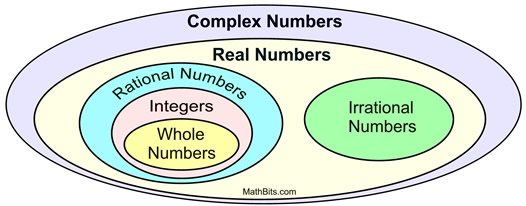Are Negative Square Roots Rational
Let's investigate what happens when negative values appear under the radical symbol (as the radicand) for cube roots and square roots.
In some situations, negative numbers under a radical symbol are OK. For example, ![]() is not a problem since (-2) • (-2) • (-2) = -8, making the answer -2. In cube root bug, it is possible to multiply a negative value times itself three times and get a negative answer.
is not a problem since (-2) • (-2) • (-2) = -8, making the answer -2. In cube root bug, it is possible to multiply a negative value times itself three times and get a negative answer.
Difficulties, notwithstanding, develop when we look at a problem such as ![]() . This square root problem is request for a number multiplied times itself that will give a production (answer) of -16. There simply is no way to multiply a number times itself and get a negative result. Consider: (four) • (4) = 16 and (-four) • (-iv) = sixteen.
. This square root problem is request for a number multiplied times itself that will give a production (answer) of -16. There simply is no way to multiply a number times itself and get a negative result. Consider: (four) • (4) = 16 and (-four) • (-iv) = sixteen.
| CUBE ROOTS: | BUT | Foursquare ROOTS: |
| Yes, (-two) x (-2) x (-2) = -eight. | Nope! (4) x (4) ≠ -sixteen. |
![]() Square roots are the culprits! The difficulties arise when you come across a negative value under a foursquare root. It is not possible to foursquare a value (multiply it times itself) and arrive at a negative value. So, what do we do?
Square roots are the culprits! The difficulties arise when you come across a negative value under a foursquare root. It is not possible to foursquare a value (multiply it times itself) and arrive at a negative value. So, what do we do?
| | The square root of a negative number does not exist among the set up of Real Numbers. |
When problems with negatives under a square root kickoff appeared, mathematicians idea that a solution did not exist. They saw equations such as x 2 + 1 = 0 , and wondered what the solution In an effort to address this trouble, mathematicians "created" a new number,![]() really meant.
really meant.
| | The imaginary number "i" is the foursquare root of negative one. |
![]()
An imaginary number possesses the unique property that when squared, the consequence is negative.

Consider: ![]()
The process of simplifying a radical containing a negative factor is the same equally normal radical simplification. The simply difference is that the ![]() will be replaced with an " i ".
will be replaced with an " i ".
Every bit research with imaginary numbers continued, information technology was discovered that they actually filled a gap in mathematics and served a useful purpose. Imaginary numbers are essential to the report of sciences such equally electricity, quantum mechanics, vibration analysis, and cartography.
When the imaginary i was combined with the set up of Existent Numbers, the all encompassing set of Circuitous Numbers was formed.

Production Rule
![]()
where a ≥ 0, b≥ 0
"The square root of a production is equal to the product of the square roots of each factor."
This theorem allows the states to use our method of simplifying radicals.
Imaginary (Unit) Number ![]()
![]()
Production Rule
(extended) ![]() where a ≥ 0, b≥ 0
where a ≥ 0, b≥ 0
OR a ≥ 0, b < 0
but
Non a < 0, b < 0 ![]()
FYI: The powers of i ever bicycle through only 4 dissimilar values:
i 1 = i
i 2 = -ane
i 3 = -i
i 4 = one
i 5 = i and the cycle starts over again.
When doing arithmetic on i , treat it as yous would an "x".
3 i + 4 i = 7 i
2 i • 4 i = 8 i 2 = -8
Annotation: i 2 was replaced with -i.
Do Not misfile "irrational" numbers
with
"imaginary" numbers.
They are NOT the aforementioned.
Complex Numbers
a ± bi
where a and b are real numbers, and i is the imaginary unit.
Complex numbers are written in the standard form a + bi.
In Algebra 1, you will see that the "imaginary" number will be useful when solving quadratic equations. The quadratic formula may requite complex solutions, written as a ± bi, where a and b are real numbers.
Y'all will see more than near imaginary numbers in the Quadratic department.
Are Negative Square Roots Rational,
Source: https://mathbitsnotebook.com/Algebra1/Radicals/RADNegativeUnder.html
Posted by: robertscoge1939.blogspot.com


0 Response to "Are Negative Square Roots Rational"
Post a Comment